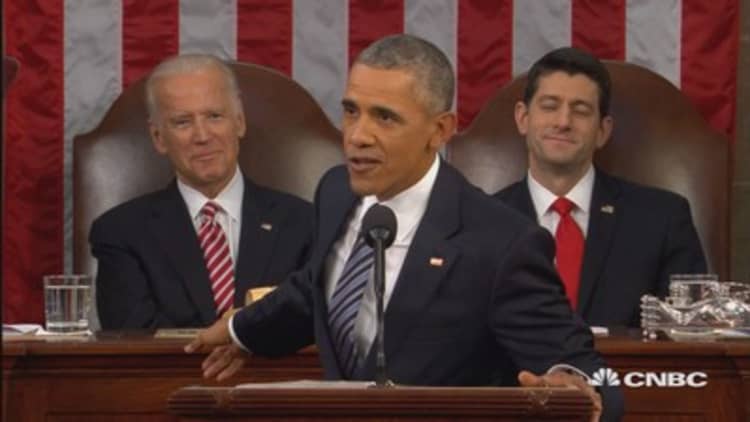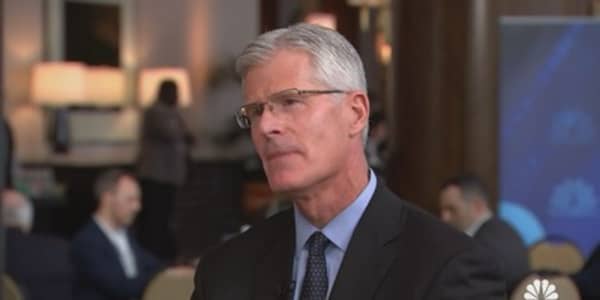With Washington locked in a fight over whether to wait until next year to fill the seat of the late Supreme Court Justice Antonin Scalia and the likelihood high that the next Justice will ultimately decide the fate of President Obama's climate-change plan, available evidence suggests that the economic cost of the transition away from coal-fired electricity is fairly modest.
As Environmental Protection Agency administrator Gina McCarthy prepares to defend the plan in a speech at the IHS CERAWeek energy conference on Wednesday, politicians in the 27 states challenging the plan in court are focused on two main impacts: How the rules hurt the coal industry, since limits on carbon emissions would push utilities to rely on lower-carbon natural gas or carbon-free renewable energy and nuclear power, and the effect on utility rates as utilities pay for new plants.
Yet utilities, which account for 93 percent of U.S. coal usage, have already begun to comply with the mandates, having cut carbon emissions 18 percent since 2005 — more than halfway to the plan's goal of forcing 32 percent reductions from 2005 levels by 2030. Coal accounted for just 34 percent of U.S. electricity generation last year, based on a full-year estimate in the recent Sustainable Energy in America Factbook, which would represent the lowest level in the modern history of the utility industry, based on data that has been kept by the Energy Information Administration since 1949.
At the same time, gains in electricity prices have all but halted. They rose 1.2 percent last year and were falling late in 2015, in sharp contrast to the 18 percent inflation in electricity in 2006, according to Labor Department figures. Even job losses in the coal industry have slowed, compared to their pace in earlier periods when automation forced thousands of miners out of work.
"It will definitely hurt further," said John Deskins, director of the Bureau of Business and Economic Research at West Virginia University. But the state's coal industry has already been getting hit by the mechanization of work, China's slowing coal demand and lower natural-gas prices. "I just know all three of those factors are important," Deskins said.
Scalia's last vote on the court was to support a Feb. 9 injunction, issued by a 5–4 vote, barring enforcement of the Obama administration's Clean Power Plan until it can be heard by the courts. The D.C. Circuit Court had declined to issue a stay in the case weeks earlier, instead setting an accelerated time line for the case and a June 2 date for oral argument.
If the case comes back to the Supreme Court for hearing on the merits, probably next year, it's likely the next Justice will cast the deciding vote. If the standoff between President Obama and the Senate prevents the seat from being filled before then, the ruling of the D.C. Circuit after the June hearing would be preserved by a 4–4 vote on appeal. On Tuesday, the Senate Republicans made it clear they had no intention of even acknowledging a Supreme Court nominee from President Obama.
Three industries make up only a small proportion of Kentucky's economy (around 2 percent), and that is a good thing, because they are declining industries. Growth will not likely come from coal, horses or bourbon.Christopher Bollingerdirector of the University of Kentucky's Center for Business and Economic Research, in its 2016 annual forecast
There's little doubt that the plan would hurt sales of coal, an industry the U.S. Department of Energy claims generated about $36.5 billion of 2014 U.S. sales before prices collapsed last year. Since reaching a high point in 2008, coal production in the United States has continued to decline. U.S. coal production in 2015 was expected to be about 900 million short tons (MMst), 10 percent lower than in 2014 and the lowest level since 1986, according to U.S. Energy Information Administration data released early this year. In West Virginia, Deskins estimates that sales would fall 20 percent from today's levels of 95 million to 100 million short tons per year, with coal-industry employment falling by about the same amount.
But even in coal-producing states, coal is only a small part of the economy. And the coal industry had huge problems even before the Clean Power Plan came along.
In states like West Virginia and Kentucky, the two states with the most direct coal employment, the challenge is to move from local economies based on mining to a broader mix. It's a challenge that Kentucky has been managing more easily than its neighbor.
Kentucky's 9,200 remaining coal jobs, down from 29,000 in 1990, are less than a quarter of the 40,000 jobs the state added last year and less than 1 percent of total jobs, according to the Labor Department's Bureau of Labor Statistics. In West Virginia, coal-mining jobs are 2.4 percent of about 750,000 jobs statewide. West Virginia lost 12,000 jobs in total last year.
"Coal mining, beverage manufacturing and animal production [are] sub-industries that are typically viewed as important in Kentucky," Christopher Bollinger, director of the University of Kentucky's Center for Business and Economic Research, wrote in the center's 2016 forecast.
"Together these three industries make up only a small proportion of Kentucky's economy (around 2 percent), and that is a good thing, because they are declining industries. Growth will not likely come from coal, horses or bourbon."
In the broken heart of coal country
The big problems for "coal country" now are weak export markets, especially China, and competition from natural gas, the price of which has fallen 85 percent from pre-recession peaks.
The EIA full-year 2015 data projections expect that China, the world's largest coal consumer, imported less than 0.5 short tons (MMst) from the U.S., down from 8.3 MMst from the United States in 2013, about 7 percent of total U.S. coal exports that year. In 2014, U.S. coal exports to China decreased to 1.8 MMst. Based on Census Bureau data through September 2015, and estimates for the remainder of the year, EIA expected total U.S. coal industry exports of 77 MMst, a 21 percent decline from the previous year.
In places like these, the challenge is to help people find other work to do — often by leaving their hometowns, Deskins said. It has been easier for Kentucky, which has seen strong growth in services employment around Louisville and Lexington. It's a challenge he faced himself, coming from a Virginia county that borders coal-producing country in southern West Virginia, he said.
McDowell County West Virginia, in the heart of coal country, has dwindled to 20,000 people, losing 7.5 percent of its population since 2010 and more than 80 percent since 1950, according to census data. The less-trained workforce in West Virginia also kept it from benefiting as much from fracking for natural gas, as many workers had to be imported from states like Oklahoma, Deskins said.
"When I was 18, there was no question I would leave," he said.
About 73,800 people work in the coal business nationwide, out of 143.3 million overall workers, at an average wage of $55,740, according to the Labor Department. That includes not only the 16,000 miners classified as working in "extraction" but also people who work transporting the coal, finance and administrative people at coal companies, and about 2,200 executives. The EPA estimates the plan will force elimination of about 15,000 coal-industry jobs, as the percentage of electricity coming from coal slips to 27 percent.

The main source of other coal-related employment is in more than 600 utility plants around the U.S., down from 1,522 in 2005, according to SourceWatch. An estimated 60,000 people hold utility jobs tied to coal. The EPA estimates that coal-fired power plants will cut about 13,000 jobs by 2030.
Rising utility rates may hit hardest in states that use the most coal for electricity, including North Dakota, Missouri, Indiana and Utah, as well as top coal-producing states Wyoming, Kentucky and West Virginia. It will have much less impact on West Coast states, like California, that are already moving away from coal, and most Northeastern states are well on the way to meeting their CPP obligations.
For utility rates, the question is whether the cost of replacing coal-fired plants with something new are greater than the savings from cheaper fuel. Natural gas is now cheaper than coal for most utility uses, and wind and solar power don't use fuel. Rates are set partly by incorporating the capital cost of new plants into rates over the life of the plant, letting utilities repay debt incurred to build them.
Replacing plants will boost utilities' capital spending by between $29 billion and $39 billion a year, according to NERA Economic Consulting, a unit of Marsh & McLennan. Utility rates will rise 11 percent to 14 percent, the firm says, with 10 states seeing 30 percent hikes or more. Between now and 2031, the plan will cost consumers as much as $79 billion, NERA says.
Peabody Energy, which produces 10 percent of U.S. electricity and also has an ownership interest in a 1,600 megawatt coal-fueled electricity generation plant in the U.S., wrote in an amicus brief to the Supreme Court supporting the coal industry's case, "This case demonstrates the astonishing consequences of an agency's failure to take costs and risk trade-offs into account. … The upshot of EPA's conclusion is a Rule with estimated costs of $9.6 billion annually. ... Further, even EPA's huge figure of $9.6 billion in costs represents a severe underestimation."
Peabody stated in its court brief, "The Rule will cause a significant percentage of power plants to shut down and will also result in job losses, decreased reliability of the electrical grid, and higher prices for electricity and consumer goods. … The massive costs associated with EPA's proposal will cause significant social hardship. For millions of lower-income households, high energy costs force hard decisions about what bills to pay — housing, food, education, health care, or other necessities. … The costs will almost certainly have a disproportionate impact on the poorest segments of the population."
Blue-collar families can spend as much as 22 percent of their incomes on energy, including both gasoline and electricity, making swings in power prices hurt, said Paul Bailey, senior vice president for federal affairs at the American Coalition for Clean Coal Electricity, which commissioned NERA's study.
"It's a big deal because of the electricity rates," Bailey said. "Even EPA has bigger numbers in their state-by-state figures.''
But this hasn't happened in states that are closer to complying with the law, or nationwide, as coal's share of U.S. power generation has fallen by a third since 2005, environmentalists argue. Texas has been a leader in deploying wind energy, and its rates have dropped 9 percent since 2008, while the national average rose 7 percent, according to the Energy Information Administration. Adjusted for broader inflation, electricity is 5.8 percent cheaper than in 2008, according to the Business Council for Sustainable Energy.
"Surging renewables build and coal retirements have not triggered a dramatic leap in retail power prices,'' the council said in a report this month. "Year on year, retail rates in 2015 fell 1.3 percent in real terms, even as real GDP grew by 2.4 percent."
— By Tim Mullaney, special to CNBC.com







